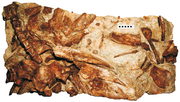Edmontonia is a genus of panoplosaurin nodosaurid dinosaur from the Late Cretaceous Period. It is part of the Nodosauridae, a family within Ankylosauria...
29 KB (3,527 words) - 12:34, 14 October 2024
Denversaurus (redirect from Edmontonia schlessmani)
referred the find to Edmontonia longiceps. In 1988, Robert Thomas Bakker decided to split the genus Edmontonia. The species Edmontonia rugosidens was made...
9 KB (1,001 words) - 04:10, 22 July 2023
includes not only the Late Cretaceous Panoplosaurus, Denversaurus and Edmontonia, but also the mid Cretaceous Animantarx and Texasetes, as well as Patagopelta...
32 KB (2,049 words) - 12:41, 14 October 2024
were rare in Laramidia, and there were only specialized forms, such as Edmontonia and Panoplosaurus. This is an example of how isolated faunas develop differently...
8 KB (203 words) - 19:46, 22 July 2024
Glyptodontopelta (redirect from Edmontonia australis)
supraorbital and bone fragments. It was named in 2000 by Tracy Ford. Edmontonia australis is a junior synonym of Glyptodontopelta. Fossils of Glyptodontopelta...
5 KB (415 words) - 23:42, 22 August 2024
been considered the proper name for material otherwise referred to as Edmontonia, complicating its phylogenetic and ecological interpretations, at one...
63 KB (7,476 words) - 12:41, 14 October 2024
is tall, and similar coracoid to scapula proportions to Animantarx and Edmontonia. The skull of Peloroplites has an estimated length of 56 cm and a maximum...
32 KB (3,576 words) - 12:42, 14 October 2024
experienced male and the Edmontonia has found a last leaf. Suddenly, the log she stands on breaks apart and the Edmontonia slides down the snow on her...
9 KB (1,344 words) - 02:26, 19 October 2024
conflated with that of Edmontonia (earlier referred to as Palaeoscincus); in addition to Ankylosaurus being depicted with spikes, Edmontonia has also been depicted...
65 KB (7,680 words) - 06:16, 27 October 2024








